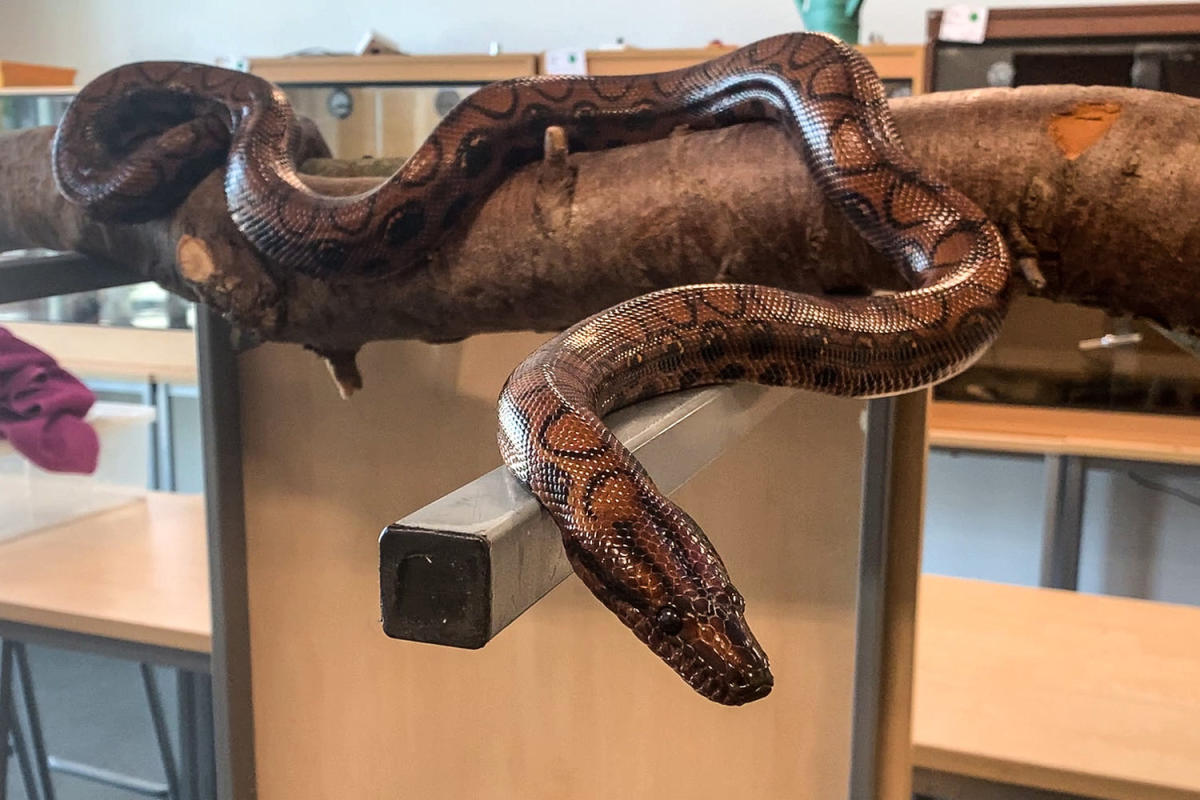Ronaldo, a 6-foot-long Brazilian rainbow boa constrictor kept at a school in England, was mistaken for a male until the snake gave birth to 14 young last month.
The boa had not had contact with another snake for almost ten years, so it appears that she had undergone a natural process of asexual reproduction called parthenogenesis. The term is derived from the Greek words for “virgin birth.”
According to the school, this is the third documented case of this type of birth in a Brazilian rainbow boa in captivity.
Ronaldo attends City of Portsmouth College, an academic and vocational training course for 16- to 18-year-olds in southern England, where the slang is used to teach schoolchildren how to care for animals.
“I got a call from a colleague asking me why I had released a couple of little snakes with Ronaldo,” said Pete Quinlan, a veterinary assistant at the university who has cared for the snake for the past nine years.
Quinlan said his first thought that day, June 21, was that there had been a mistake. Even though it was his day off, Quinlan went inside and immediately recognized that the snakes on Ronaldo were baby rainbow boa constrictors.
“I was completely confused by it,” he said, adding that he has been working with reptiles for more than 50 years.
“I’ve literally kept thousands of snakes over that time and bred a lot of snakes,” Quinlan added. “I’ve never heard of it.”
In a press release, the college described the event as a “miraculous birth,” although it is known that some snakes and other animals – including crocodiles and honeybees – can produce offspring asexually.
Parthenogenesis occurs when an embryo develops without being fertilized. The process is especially rare in vertebrates, including snakes.
Unlike sexual reproduction, which requires sperm to fertilize an egg, parthenogenesis can involve byproducts of the egg-making process, called polar bodies, that are used to fill that gap. These cells are reassembled into the eggs, giving the embryos two similar — but not identical — sets of DNA.
Parthenogenesis can also occur when sex cells duplicate and then fuse again. This process produces clones of the mother, but this occurs primarily in plants, not animals.
Scientists are still investigating why parthenogenesis occurs in animals and how often.
According to Quinlan, some researchers believe that snakes undergo parthenogenesis when females are without a mate for most of their lives.
In recent years, there have been several other reports of animals reproducing asexually in captivity. Last year, a shark at the Brookfield Zoo in Illinois gave birth to a baby parthenogenesis after not having had contact with a male shark for at least four years. And a 2021 study found that California condors, a critically endangered bird, reproduced asexually in captivity despite having access to mates.
A stingray named Charlotte, who became pregnant through parthenogenesis at a North Carolina aquarium, died Sunday. The aquarium announced last month that the ray — whose story was even the subject of a “Saturday Night Live” sketch — was no longer pregnant and had been diagnosed with a rare disease.
Quinlan said he originally got Ronaldo from the Royal Society for the Prevention of Cruelty to Animals, a charity that supports animal welfare. A vet had said Ronaldo was male, and Quinlan never questioned that. It is harder to determine the sex of a snake when it is an adult than when it is a baby, he said.
Ronaldo is a “very popular snake” at school, Quinlan said, adding that the students had never cared for newborn snakes before, so this should be a “really good experience” for them.
Evie Allen, A university student who works with Ronaldo said she was “shocked” and “confused” when a friend told her the snake had given birth.
“I really thought he was joking,” she said.
The college plans to keep one or two of the baby snakes and care for the rest until they have had a few meals and are healthy enough to go to new homes.
Ronaldo’s story has captured worldwide attention.
“I didn’t expect it to go so viral,” said Paula Hetherington, who manages marketing and communications for the college.
“If you Google Ronaldo the snake now, it seems to be more popular than Ronaldo the footballer,” Quinlan said.
This story first appeared on NBCNews.com.
This article was originally published on TODAY.com
